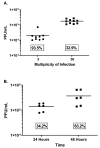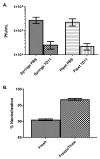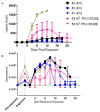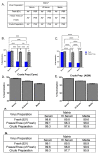Evaluation of Virulence in Cynomolgus Macaques Using a Virus Preparation Enriched for the Extracellular Form of Monkeypox Virus
- PMID: 36146799
- PMCID: PMC9505131
- DOI: 10.3390/v14091993
Evaluation of Virulence in Cynomolgus Macaques Using a Virus Preparation Enriched for the Extracellular Form of Monkeypox Virus
Abstract
The 2022 global human monkeypox outbreak emphasizes the importance of maintaining poxvirus research, including enriching a basic understanding of animal models for developing and advancing therapeutics and vaccines. Intravenous administration of monkeypox virus in macaques is arguably one of the best animal models for evaluating the efficacy of medical countermeasures. Here we addressed one criticism of the model, a requirement for a high-titer administration of virus, as well as improving our understanding of monkeypox virus pathogenesis. To do so, we infected macaques with a challenge dose containing a characterized inoculum enriched for the extracellular form of monkeypox virus. Although there were some differences between diseases caused by the enriched preparation compared with a relatively similar unpurified preparation, we were unable to reduce the viral input with the enriched preparation and maintain severe disease. We found that inherent factors contained within the serum of nonhuman primate blood affect the stability of the monkeypox extracellular virions. As a first step to study a role of the extracellular form in transmission, we also showed the presence of this form in the oropharyngeal swabs from nonhuman primates exposed to monkeypox virus.
Keywords: countermeasures; dissemination; extracellular virion; model; monkeypox; morphogenesis; nonhuman primates; orthopoxvirus; smallpox; transmission; viremia.
Conflict of interest statement
The authors declare no conflict of interest.
Figures







Similar articles
-
Effect of Monkeypox Virus Preparation on the Lethality of the Intravenous Cynomolgus Macaque Model.Viruses. 2022 Aug 9;14(8):1741. doi: 10.3390/v14081741. Viruses. 2022. PMID: 36016363 Free PMC article.
-
Experimental infection of cynomolgus macaques (Macaca fascicularis) with aerosolized monkeypox virus.PLoS One. 2010 Sep 20;5(9):e12880. doi: 10.1371/journal.pone.0012880. PLoS One. 2010. PMID: 20862223 Free PMC article.
-
Sequence of pathogenic events in cynomolgus macaques infected with aerosolized monkeypox virus.J Virol. 2015 Apr;89(8):4335-44. doi: 10.1128/JVI.03029-14. Epub 2015 Feb 4. J Virol. 2015. PMID: 25653439 Free PMC article.
-
A Glance at the Development and Patent Literature of Tecovirimat: The First-in-Class Therapy for Emerging Monkeypox Outbreak.Viruses. 2022 Aug 25;14(9):1870. doi: 10.3390/v14091870. Viruses. 2022. PMID: 36146675 Free PMC article. Review.
-
Human monkeypox: an emerging zoonotic disease.Future Microbiol. 2007 Feb;2(1):17-34. doi: 10.2217/17460913.2.1.17. Future Microbiol. 2007. PMID: 17661673 Review.
Cited by
-
Exploring monkeypox virus antibody levels: insights from human immunological research.Virol J. 2025 May 31;22(1):175. doi: 10.1186/s12985-025-02748-0. Virol J. 2025. PMID: 40450351 Free PMC article. Review.
-
Human Monkeypox Virus and Host Immunity: New Challenges in Diagnostics and Treatment Strategies.Adv Exp Med Biol. 2024;1451:219-237. doi: 10.1007/978-3-031-57165-7_14. Adv Exp Med Biol. 2024. PMID: 38801581 Review.
-
The Human Monkeypox Virus and Host Immunity: Emerging Diagnostic and Therapeutic Challenges.Infect Disord Drug Targets. 2025;25(2):e18715265309361. doi: 10.2174/0118715265309361240806064619. Infect Disord Drug Targets. 2025. PMID: 39161149 Review.
-
Progress and prospects on vaccine development against monkeypox infection.Microb Pathog. 2023 Jul;180:106156. doi: 10.1016/j.micpath.2023.106156. Epub 2023 May 16. Microb Pathog. 2023. PMID: 37201635 Free PMC article. Review.
-
Clade IIb Mpox virus (MPXV) vertical transmission and fetal demise in a pregnant rhesus macaque model.PLoS One. 2025 Apr 1;20(4):e0320671. doi: 10.1371/journal.pone.0320671. eCollection 2025. PLoS One. 2025. PMID: 40168332 Free PMC article.
References
-
- Adler H., Gould S., Hine P., Snell L.B., Wong W., Houlihan C.F., Osborne J.C., Rampling T., Beadsworth M.B., Duncan C.J., et al. Clinical features and management of human monkeypox: A retrospective observational study in the UK. Lancet Infect. Dis. 2022;22:1153–1162. doi: 10.1016/S1473-3099(22)00228-6. - DOI - PMC - PubMed
-
- Huggins J., Goff A., Hensley L., Mucker E., Shamblin J., Wlazlowski C., Johnson W., Chapman J., Larsen T., Twenhafel N., et al. Nonhuman primates are protected from smallpox virus or monkeypox virus challenges by the antiviral drug ST-246. Antimicrob. Agents Chemother. 2009;53:2620–2625. doi: 10.1128/AAC.00021-09. - DOI - PMC - PubMed
-
- Mucker E.M., Chapman J., Huzella L.M., Huggins J.W., Shamblin J., Robinson C.G., Hensley L.E. Susceptibility of Marmosets (Callithrix jacchus) to Monkeypox Virus: A Low Dose Prospective Model for Monkeypox and Smallpox Disease. PLoS ONE. 2015;10:e0131742. doi: 10.1371/journal.pone.0131742. - DOI - PMC - PubMed
-
- Mucker E.M., Wollen-Roberts S.E., Kimmel A., Shamblin J., Sampey D., Hooper J.W. Intranasal monkeypox marmoset model: Prophylactic antibody treatment provides benefit against severe monkeypox virus disease. PLoS Negl. Trop. Dis. 2018;12:e0006581. doi: 10.1371/journal.pntd.0006581. - DOI - PMC - PubMed
Publication types
MeSH terms
LinkOut - more resources
Full Text Sources
Medical
Research Materials

